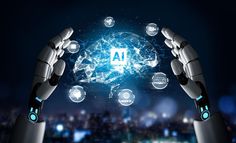- AI definition.
- Top branches of AI.
- AI applications.
AI definition:
The rapid advancement of artificial intelligence technology has revolutionized numerous industries, bringing about significant changes and improvements. Artificial intelligence systems, which are designed to replicate human intelligence, have the ability to learn, reason, and execute tasks with remarkable accuracy and comprehension. Knowledge and familiarity with the diverse concepts underpinning artificial intelligence are essential for effectively addressing real-world issues.
we will explore the main branches of artificial intelligence, highlighting its various applications and implications across different domains.
The top branches in AI are:
- Machine learning
- Neural networks/deep learning
- Natural language processing
- Computer vision
- Expert systems
- Robotics
Machine Learning:
Machine learning is a subset of artificial intelligence that focuses on the development of algorithms and models that enable computers to learn from and make predictions or decisions based on data. It involves training machines to recognize patterns, adapt and improve over time without being explicitly programmed. Machine learning is used in a wide range of applications, including recommendation systems, predictive analytics, fraud detection, and more.
Neural Networks/Deep Learning:
Neural networks are a type of artificial intelligence model inspired by the human brain's structure and functioning. Deep learning is a subset of neural networks that involves training networks with multiple layers to learn complex patterns and representations in data. Deep learning has led to significant advancements in areas such as image and speech recognition, natural language processing, and autonomous driving.
Natural Language Processing:
Natural Language Processing (NLP) is a branch of artificial intelligence that focuses on the interaction between computers and human language. NLP enables machines to understand, interpret, and generate human language, allowing for tasks such as sentiment analysis, language translation, chatbots, and speech recognition. NLP has become increasingly important as businesses seek to leverage the vast amount of unstructured text data available.
Computer Vision:
Computer vision is a field of artificial intelligence that enables machines to interpret and understand visual information from images or videos. It involves developing algorithms that can analyze and recognize objects, patterns, and scenes in images, leading to applications such as facial recognition, object detection, autonomous vehicles, and medical image analysis.
Expert Systems:
Expert systems are AI systems that emulate the decision-making abilities of human experts in specific domains or areas of expertise. These systems use rules and logical reasoning to solve complex problems, make recommendations, or provide expert-level insights. Expert systems have been applied in various fields, including healthcare, finance, engineering, and customer service.
Robotics:
Robotics combines artificial intelligence, engineering, and other fields to develop intelligent machines, known as robots, that can perform tasks, interact with the environment, and make autonomous decisions. Robotics has applications in manufacturing, healthcare, agriculture, space exploration, and more, and plays a crucial role in advancing technology and improving efficiency in various industries.
AI Applications:
AI applications are transforming various industries and impacting our daily lives in numerous ways. Here are some of the key AI applications:
1. Healthcare: AI is being used in healthcare for tasks such as medical imaging analysis, predictive analytics, personalized medicine, and drug discovery. AI-powered tools can help doctors make more accurate diagnoses, recommend treatment plans, and improve patient outcomes.
2. Finance: In the finance industry, AI is used for fraud detection, risk assessment, algorithmic trading, customer service chatbots, and personalized recommendations. AI algorithms can analyze vast amounts of financial data to identify patterns and make informed decisions in real-time.
3. Retail: AI applications in retail include personalized recommendations, inventory management, demand forecasting, customer service chatbots, and visual search. AI-powered tools can help retailers optimize their operations, enhance the customer shopping experience, and increase sales.
4. Transportation: AI is driving innovation in transportation with applications such as autonomous vehicles, traffic management systems, predictive maintenance, and route optimization. AI technologies are helping to improve safety, efficiency, and sustainability in transportation networks.
5. Marketing: AI is revolutionizing marketing with applications like customer segmentation, targeted advertising, content optimization, and chatbots for customer interactions. AI-powered tools can analyze customer behavior, preferences, and trends to create more effective marketing strategies.
6. Agriculture: AI applications in agriculture include crop monitoring, yield prediction, soil analysis, pest detection, and precision farming. AI technologies are helping farmers make data-driven decisions to increase productivity, optimize resources, and reduce environmental impact.
7. Education: AI is being used in education for personalized learning, student assessment, virtual tutoring, and educational content creation. AI-powered tools can adapt to individual student needs, provide real-time feedback, and enhance the learning experience.
8. Cybersecurity: AI is used in cybersecurity for threat detection, anomaly detection, fraud prevention, and security monitoring. AI algorithms can analyze vast amounts of data to identify and respond to potential security threats in real-time.
These are just a few examples of the diverse AI applications that are shaping the future of various industries and driving innovation in technology and business. AI continues to evolve and expand its reach across different sectors, offering new opportunities for efficiency, productivity, and advancement.

